[ Home | What's New | Articles ]
[Here is a "slide show" version with larger pictures]
The end of January and first week of February, 1997 I had to take a business trip to Carlisle, Pennsylvania. I decided to take the opportunity to save some shipping costs and made arrangements to purchase 250 new 1-1/4" x 8" insulator pins from May & Bigley, Inc. May & Bigley is one of the few, if not the only, manufacturer of wooden insulator pins and other wooden pole line products left in operation in the U.S.A. Their mail address is May & Bigley, Inc., P.O. Box 667, Bedford, PA 15522, phone number (814)623-9414.
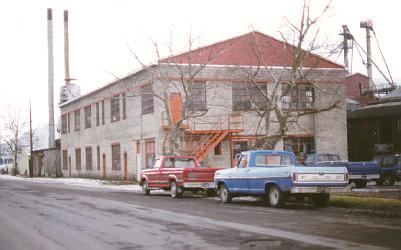
Figure 1 |
Directions to the plant are as follows: Take the Bedford exit from the Pennsylvania turnpike. After going through the toll booth take a right at the first stop sign. Proceed down this road about 2 miles until you come to a stop light. Just before the stop light there is a Exxon gas station on the right. Just before the gas station is Railroad Street. Turn right and go about one block. Look for the two smoke stacks (see figure 1) and you will see their building on the left.
You can park at the end of the building. The large window on the side of the building at the end is the office. When you enter through the door there is a small hallway that goes by the office.
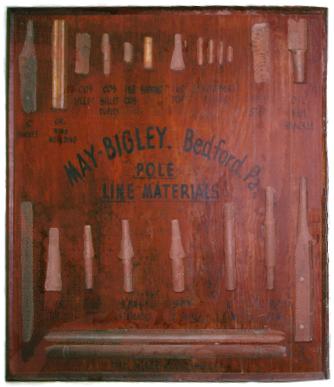
Figure 2 |
There on the wall is a large plywood board with examples of all of the wooden pole line products they manufacture (see figure 2). The products are (from upper left to right):
![]() C Bracket
C Bracket ![]() Ground
Wire Molding (covers the ground wire that runs down the side of utility poles)
Ground
Wire Molding (covers the ground wire that runs down the side of utility poles) ![]() Cob
Billet
Cob
Billet ![]() Cob Billet Duplex
Cob Billet Duplex ![]() Insulator
Cob
Insulator
Cob ![]() Bushings
Bushings ![]() Insulator
Top
Insulator
Top ![]() Wooden Plugs
Wooden Plugs ![]() Pole
Step
Pole
Step ![]() Oil Well Shackle (bottom row left
to right)
Oil Well Shackle (bottom row left
to right) ![]() Stake
Stake ![]() 8"
Insulator Top
8"
Insulator Top ![]() 8" Insulator Pin
8" Insulator Pin ![]() 9"
Pin Unthreaded
9"
Pin Unthreaded ![]() 9" Pin with 2"
Shoulder
9" Pin with 2"
Shoulder ![]() 11" Pin
11" Pin ![]() 12"
Duplex Pin
12"
Duplex Pin ![]() 21" Pin (bottom center)
21" Pin (bottom center)
![]() Tree Wire Molding
Tree Wire Molding
Most of the products are made right there in this building. The pins, bushings, plugs and cobs are made of locust and the brackets, pole steps, ground-wire moulding, & stakes are made of oak. They make most of the Ground Wire Molding and Tree Wire Molding at another plant in town. The Ground Wire Molding is their current �bread and butter� product.
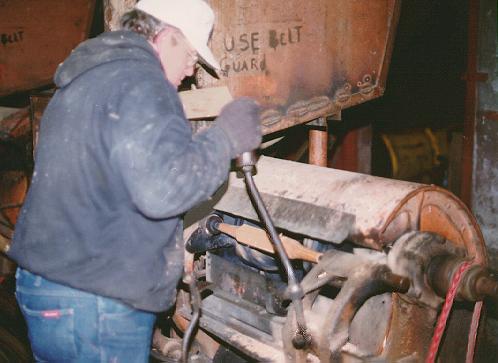
Figure 3 |
It all starts with wood logs that have been cut and are stacked out at the far end of the parking lot. Those are brought into the building and debarked. They are then taken upstairs where they are sawn into sized blocks for the type of product to be made. These blocks are loaded into a shut that goes to a hopper down on the first floor by one of the cutting machines. A worker then takes a block and clamps it into the machine and presses it against the spinning cutter heads (see figure 3). Both the wooden block and the cutter heads spin in the same direction so that when the wooden block is pressed toward the cutter heads it is trimmed all the way around the block. The product the crew was working on the day I was there was the C Bracket. [In the hobby we call these by the more familiar term "side pins"]
There are ten of the cutter work stations down on the first floor, but it looked like only one was used on a regular basis. In its hay-days this plant probably employed from 20 to 40 people on a pretty much full time basis. Today it is a four man operation.
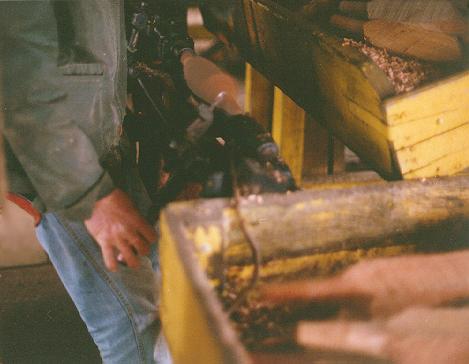
Figure 4 |
The trimmed block is then sent up to the second floor on a conveyor belt where it goes into a hopper in front of the threading machine. A worker then takes the shaped block and clamps it into the threading machine. This machine spins the shaped block and the operator rotates a cutting tool with a cutting head on it, sort of like a wood carvers V-shaped carving tool bit, down onto the spinning block (see figure 4).
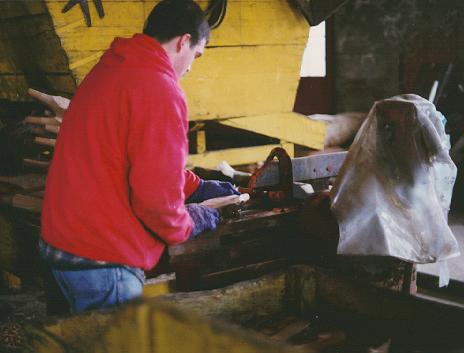
Figure 5 |
The angle of attack of the tool is such that as the tool bit cuts a gouge in the wood it is forced down the trimmed shank of the block resulting in a screw thread being cut in the shank of the block. The operator then stops the spinning piece, unclamps it, reverses ends, reclamps it and threads the other end. Once he has threaded both ends he stacks the pieces in a hopper table. From there a worker takes the pieces and saws them in two halves and trims the wedge ends on a table saw (see figure 5). Thus each block results in two C Brackets.
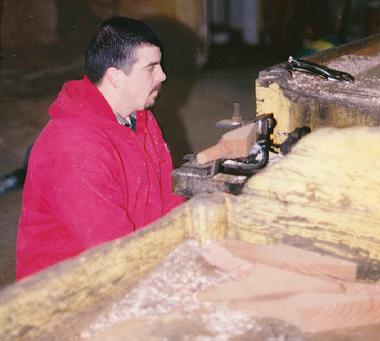
Figure 6 |
The two Pieces of C Bracket are then stacked on another hopper table until another worker lines them up and drills the installation holes in them on a twin barreled horizontal drilling machine. Figure 6 shows a worker lining up a piece to be drilled and adjusting the stop plates on the drill.
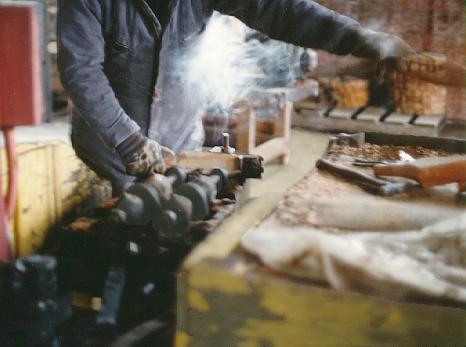
Figure 7 |
Figure 7 shows the twin barrel horizontal drill press drilling the two mounting holes in a bracket and burning a little wood in the process. The finished C Brackets are then wired together in a wheel arrangement so that a group looks like spokes of a wheel. This is how they are packaged for sale and distribution.
Well you have now seen how C Brackets are made and seen a few pictures of the process. If you ever want to buy some insulator pins just call May & Bigley and they will make them and ship them to you freight collect. On most items there is a minimum order quantity that is probably a $100 or higher order price. The 250 8� pins that I bought cost $118.75. If you are interested in buying a smaller quantity, see my for sale listing.
If you are ever passing through and have the time you might want to stop by and see if and what they are working on and see them in action. It is a very interesting process and you can see most of it in 30 minutes to one hour. I was only there about 45 minutes and that included picking up and paying for my order, loading it up in my truck and going around and taking these pictures. I hope you enjoy them and stop by and see these friendly people sometime (and maybe give them some business).
![]() Return to the Research Articles
page
Return to the Research Articles
page
If you have questions or comments, please use this Feedback Form.
Written Friday, April 25, 1997